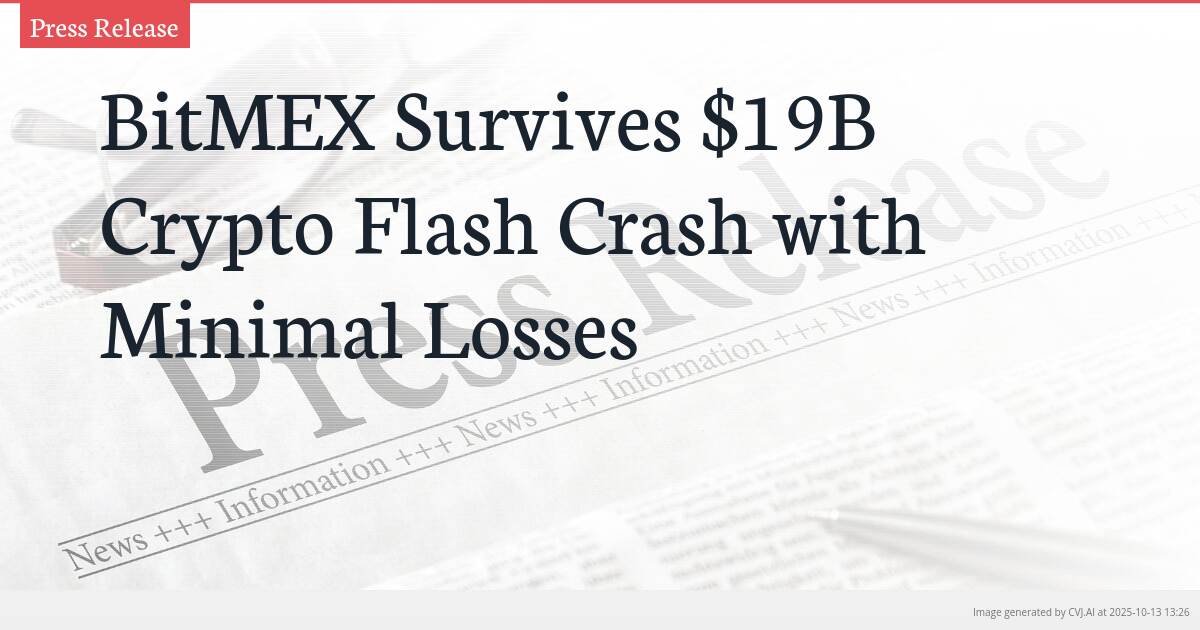This summary text is fully AI-generated and may therefore contain errors or be incomplete.
Introduction
The cryptocurrency market experienced one of the most violent deleveraging events in history on October 11, 2025, resulting in $19.35 billion in liquidations across major platforms. While competitors suffered catastrophic failures affecting over 1.6 million traders, BitMEX demonstrated remarkable resilience with only $38.50 million in liquidations, representing just 0.2% of the market total. This stark contrast reveals fundamental differences in exchange architecture and risk management philosophy that determined which platforms protected users during extreme volatility.
Key Points
- BitMEX's composite index for fair price marking prevented unjust liquidations by using weighted averages from 16 major exchanges rather than internal prices
- The exchange's auto-deleveraging mechanism protected the Insurance Fund with only $2 million in losses while ensuring platform solvency during extreme volatility
- BitMEX maintained 100% uptime and continued processing withdrawals while other exchanges suffered system overloads and operational failures
The Market-Wide Cascade: Systemic Failures Amplify Geopolitical Shock
The initial catalyst for the October 11 flash crash originated from traditional markets, triggered by a post from Donald Trump threatening significant tariffs. However, the primary driver of the cryptocurrency market’s contagion stemmed from Binance’s major systemic failure, which created a domino effect across the entire ecosystem. The flawed design of price oracles on platforms like Binance, which relied on internal spot market prices for liquidation data, failed to account for extreme illiquidity during the crisis. This created a death spiral where assets like wbETH were valued at a fraction of their real worth, leading to unjust liquidations based on erroneous data.
The scale of damage on other platforms was immense and unprecedented. According to Lookonchain, over 1,000 wallets on the derivatives DEX Hyperliquid were completely wiped out, with total user losses exceeding $1.23 billion. Hyperliquid overall saw a staggering $10.31 billion in liquidations, while Binance prepared for what may be its largest-ever compensation package. Other platforms like the PERP DEX Lighter openly acknowledged their failures, with its liquidity pool suffering its third-worst daily performance in history. These widespread failures demonstrated systems that were fundamentally unprepared to protect users from catastrophic, cascading risk during extreme market conditions.
BitMEX's Multi-Layered Defense: Engineering Stability Under Pressure
In stark contrast to the market-wide chaos, BitMEX recorded only $38.50 million in liquidations—a mere 0.2% of the $19.35 billion market total. This performance is attributable to a robust, multi-layered risk management philosophy and superior operational stability that has been refined since the exchange’s founding in 2014. The platform’s core trading infrastructure demonstrated remarkable resilience under extreme load, with no system overloads or API failures reported. While numerous competitors suffered from system-wide lag and operational disruptions, the BitMEX engine remained fully performant, ensuring traders had uninterrupted access to manage their positions throughout the period of highest volatility.
Operational integrity extended beyond trading to treasury functions, where BitMEX continued to process user withdrawals while other exchanges were forced to halt them entirely. The exchange’s fair price marking system proved particularly crucial during the crisis. Unlike platforms that used their own last-traded prices for liquidations, BitMEX employs a composite index derived from a weighted average across 16 major liquid spot exchanges. This methodology prevented localized liquidity crises or flash crashes on single constituent exchanges from triggering unjust liquidations, effectively immunizing the platform from the de-pegging spirals that devastated competitors.
The auto-deleveraging (ADL) mechanism served as the ultimate safeguard, protecting the Insurance Fund from being drained by single large illiquid positions. During the crash, 15 contracts were auto-deleveraged in a deliberate, surgical intervention that protected platform solvency while the Insurance Fund absorbed a manageable ~$2 million in losses. This last-resort mechanism filled bankrupt orders with positions of profitable, opposing traders, preventing systemic failure while minimizing collateral damage across the ecosystem.
Human Oversight and Deliberate Design: Lessons from a Decade of Volatility
BitMEX’s system incorporates human intervention as a designed failsafe for unprecedented market moves. During the crash, some mark and index prices were temporarily ‘stuck’—an intentional safety feature that caps maximum price moves to catch data errors or anomalous wicks. The BitMEX team was present throughout the entire event to verify these moves, creating a human-in-the-loop system that prevented the automated chaos caused by flawed oracles on other exchanges. This approach stands in direct contrast to fully automated systems that amplified the crisis elsewhere.
The October 11 flash crash exposed deep architectural flaws in exchange trading systems that clearly prioritize other factors over stability and user protection. As the original derivatives exchange that has weathered every crypto winter and bull run since 2014, BitMEX has always built its platform with the expectation of black swan events. The exchange’s low liquidation numbers, successful protection of user funds, 100% uptime throughout the event, and continued processing of withdrawals demonstrate the effectiveness of this philosophy. In moments of market panic, the robustness of an exchange’s core engineering proves to be what matters most for user protection and platform integrity.
📎 Read the original article on bitmex.com

